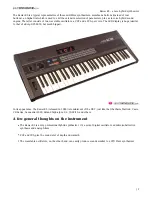
Kawai K3 – a rare hybrid synthesizer
| 14
Kawai K3
Chorus (and other effects)
This section contains more than a simple chorus. Parameter 39 (CHORUS) has 7 levels:
0 = no effect
1 = Chorus I
2 = Chorus II
3 = Chorus III
4 = Tremolo
5 = Chorus IV
6 = Chorus V
7 = Delay
These are stereo chorus, tremolo and delay effects for creating tone patches with “realistic, studio quality effects”
(?). This is what the K3 manual says. Hm …. reality is somewhat different. Most of the effects tend to be very noisy,
making it far better to turn them OFF and to use modern, external effect units instead.
K3 versus DW-8000 – a question of hardware
I never feel good about comparing instruments with each other. But sometimes you just can’t avoid it, when
discussing products with similar features. The Korg DW-8000 (again, a typical 80ies hybrid instrument with a mix of
digital and analog components) is often seen as a direct competitor to the Kawai K3. It has 16 waveforms plus VCF
and VCA. The arpeggiator is wonderful – a nice toy to play with, and an inspirational tool for creative soundscapes.
The joystick is very flexible, allowing for modulations in both X/Y directions. All in all, the performance section on the
DW-8000 is better than that on the K3. Soundwise, I’d call the K3 a little more PPG-like, while the DW-8000 offers
more raw analog sounds. Both instruments are professional synthesizers with a character in their own.
So, that’s the performance / sound point of view: on the up and up, the DW-8000 is a little ahead. And … ah yes …



















